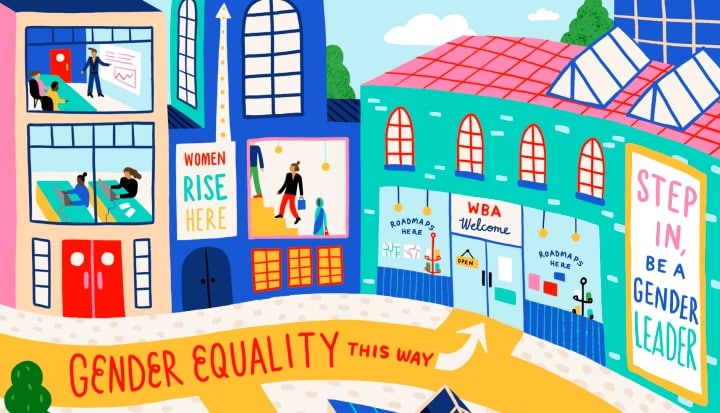Gender-based discrimination remains a persistent issue globally. Women are underrepresented in leadership positions. They are paid less than their male colleagues. They participate less in the labour force and spend more time on unpaid care and domestic work. They face sexual harassment and gender-based violence. They receive limited support for their health needs as women and mothers. And these inequalities have only been deepened by the COVID-19 pandemic, widening the gender gap even further. Yet, the business case is clear: advancing gender equality could increase global growth by $12 trillion by 2025. i To begin to address gender inequalities, we need to understand the problem.
Gender data is invisible
Apparel companies provide the ideal starting place for understanding the complex web of issues that must be overcome. The sector plays a critical role in driving gender equality and women’s empowerment, as approximately 68% of its 60 – 75 million global workforce are women. WBA’s Gender Baseline Report reveals that corporate progress toward gender equality is almost invisible. The Report assesses the world’s 36 most influential apparel companies on how they promote and drive gender equality and women’s empowerment across their value chain to determine progress on SDG 5 (Achieve gender equality and empower all women and girls) and beyond. It sheds light on corporate gender impacts – a first step all too often missing – so that progress can be made in closing the gender gap.
But here lies the first challenge, apparel companies are characterised by substantial outsourcing to multiple levels of suppliers, hiding the true scale of their workforce. This model exacerbates the problems facing women, as most suppliers are based in developing countries where women often face gender discrimination, fewer workplace protections and, where legal protections exist, weaker levels of enforcement. This gives rise to more challenging and discriminatory working conditions, including fewer formal contracts, lower wages, unpredictable working hours, increased health and safety issues, poor or non-existent maternity protection, a lack of childcare support, gender-based violence and harassment, and weaker collective bargaining opportunities.
Accordingly, when it comes to gender equality, companies need to be concerned with solving these underlying problems, rather than simply alleviating them. But how can they do so when they don’t have the data to identify their impacts on women? We have found that the 36 apparel companies assessed are not disclosing enough regarding their gender efforts.
Furthermore, even on the aspects of their value chain they do report on, sex-disaggregated data is particularly low across several metrics. These include the gender composition of company leadership, the gender pay gap, and the gender breakdown of key grievance data, such as the number of grievances reported and remediated. This is significant, because without an understanding of the extent of gender inequalities, corporate action cannot be truly effective.
It’s time to drive transformative change
The global pandemic has highlighted the importance and urgency of taking action for gender equality. The UN issued a warning highlighting the “aggravated impacts of COVID-19 for women already living on the economic margins.” ii
But, not just any change is needed – transformative change is vital to drive gender equality and women’s empowerment. If companies shifted their approach from avoiding gender-related issues and disclosing just what is legally required to proactively addressing inequalities, then wider social change could be achieved. Achievement of gender equality has the power to break the cycle of poverty. For example, ensuring that women are paid living wages for their labour can contribute to the fulfilment of a range of human rights, including the rights to food, water, health, adequate housing, education and so on. Accordingly, it is critical that companies lead this change rather than follow.
A strategic approach to gender is the way forward
The achievement of gender equality and women’s empowerment by business is fundamental to building a sustainable future that leaves no one behind. However, the pathway to achieving gender equality is not a straightforward one. It requires business to take an integrated and holistic approach across their entire value chain that considers the various dimensions affecting gender equality (e.g. representation, compensation and benefits, health and well-being, violence and harassment). Only then can companies truly drive gender-transformative and sustainable change.
WBA’s Gender Baseline Report shows that apparel companies must do better, otherwise gender equality will remain out of reach. But to sound a positive note, almost every company included in WBA’s Gender Baseline Report is taking action in some respect to drive gender equality and women’s empowerment. Our task is to accelerate these corporate efforts. To get the world to where it needs to be we need to empower women who make up more than half of the global population. The solution starts with making the invisible, visible.
Editor’s Note:
This article is part of the content for Business Fights Poverty NYC Online 2020, a one-week, online conference (21 to 25 September) that builds on our recent online conference Business Fights Poverty Online 2020 (13 to 17 July) to drive forward connection, conversations and collaboration around how we rebuild better – how together we create an equitable and resilient world. The week consists of inspiring and engaging content, live events, peer networking and community-led learning. The week also builds on our Business and COVID-19 Response with Harvard Kennedy School Corporate Responsibility Initiative, and supported by DFID and a number of our corporate partners.
Each day, we will focus on a specific theme: Imagining the Future We Want (Monday); Creating an Equitable World (Tuesday); Helping People Survive and Thrive (Wednesday); Building Resilient Livelihoods (Thursday); Shaping System-Level Partnerships (Friday).
If you were unable to join these sessions you can access all of the recordings and summaries with a Digital Pass. You can watch the opening sessions and musical performances via the links on the event page.










